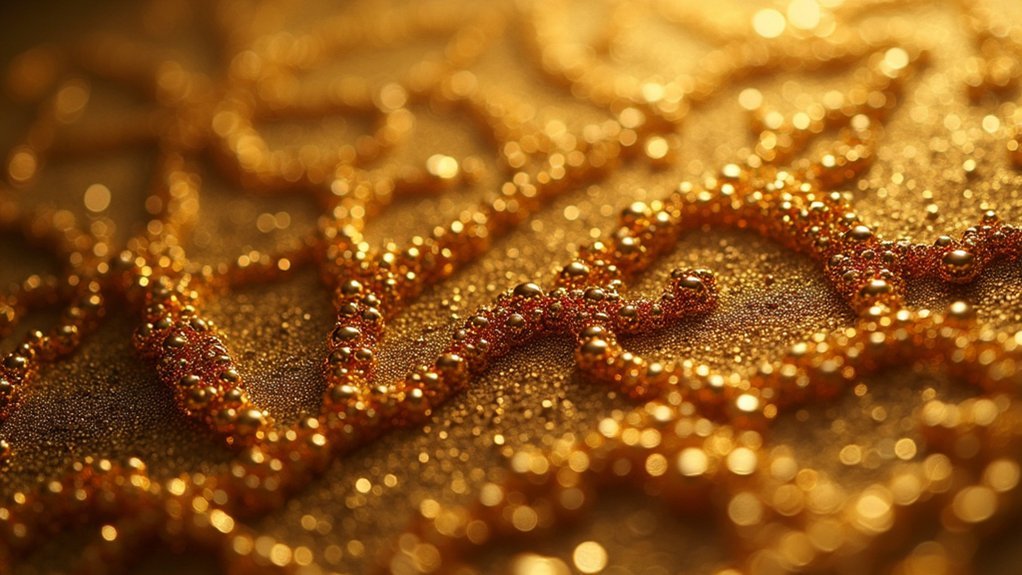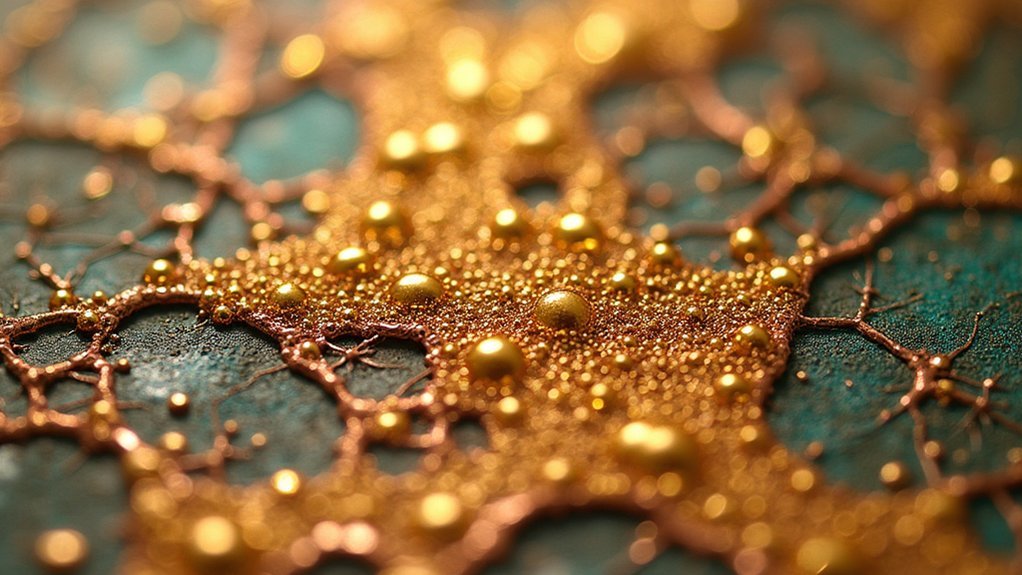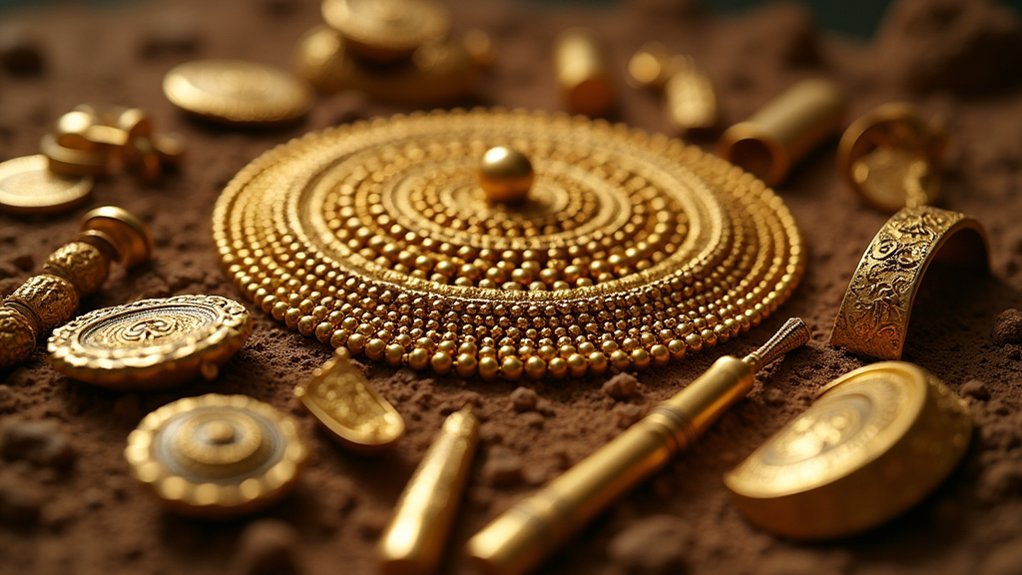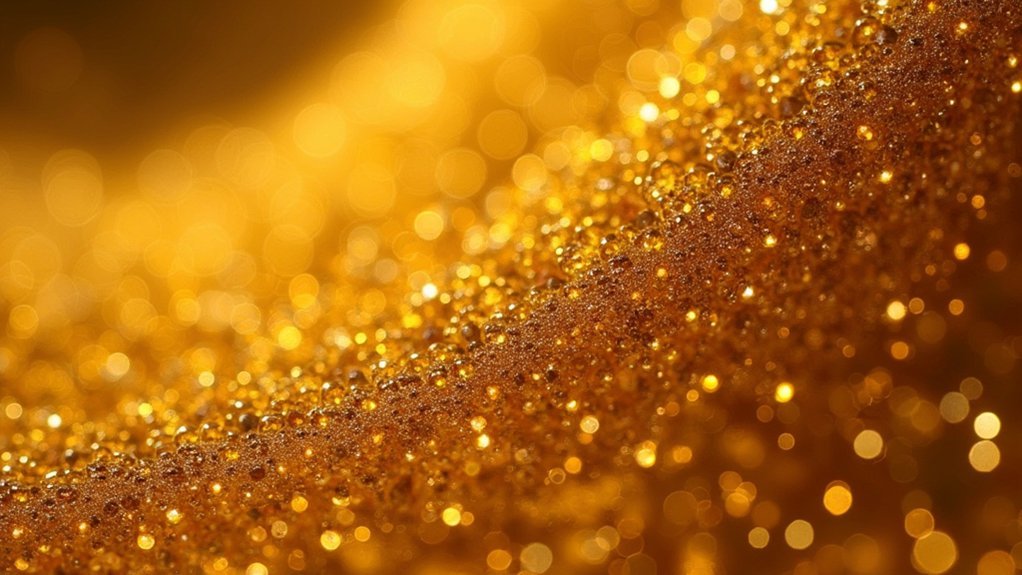You’ve probably marveled at ancient gold jewelry’s intricate patterns, but you might not realize that tiny spherical granules creating those mesmerizing designs weren’t soldered in the way you’d expect. Ancient craftsmen developed mysterious techniques that modern jewelers struggled to replicate for centuries—methods involving copper salts, precise heat control, and atmospheric conditions that created bonds so perfect they’ve survived millennia. The secrets behind these microscopic masterpieces challenge everything you think you know about metalworking.
The Ancient Origins of Granulation in Mesopotamia

While civilizations across the ancient world developed various metalworking techniques, it was in the bustling city of Ur around 2500 BCE that artisans first mastered the delicate art of gold granulation.
The ancient artisans of Ur pioneered gold granulation techniques that would influence metalworking traditions across multiple civilizations for millennia.
You’ll find the earliest examples of this revolutionary technique in royal tombs, where Sumerian goldsmiths attached tiny gold granules to surfaces, creating intricate patterns that showcased exceptional craftsmanship.
This technique originated in Mesopotamia and quickly spread throughout western Asia and the Mediterranean.
You can trace its influence through Phoenician trade routes during the orientalizing period.
The Sumerians’ innovative approach laid the foundation for later cultures like the Etruscans and Egyptians, who refined these methods to create stunning jewelry pieces that remain monuments to ancient metalworking expertise.
Etruscan Mastery and Technical Innovation
Building upon Mesopotamian foundations, the Etruscans transformed gold granulation into an art form of unparalleled sophistication between the 7th and 3rd centuries BCE.
You’ll find their goldsmiths developed revolutionary techniques that surpassed all contemporary cultures. They mastered fine powder granulation, creating intricate designs without hard solder, achieving unprecedented detail and texture in their jewelry.
What set Etruscan craftsmanship apart was their innovative colloidal soldering method. They’d mix tragacanth gum with copper salts, bonding granules at lower melting temperatures while preserving delicate patterns.
You can observe their elaborate silhouette and reserved silhouette styles, which created remarkable visual depth.
Their technical innovations were so advanced that the Castellani family’s 19th-century revival efforts highlighted Etruscan granulation’s enduring influence on modern jewelry design, proving its timeless significance.
The Mystery of Colloidal Soldering Techniques

The colloidal soldering process that made Etruscan granulation so extraordinary remains one of archaeology’s most fascinating technical puzzles.
You’ll find this ancient technique remarkably sophisticated—artisans mixed tragacanth gum with copper salts to bond granules to base metal at lower melting temperatures than traditional methods required.
When you apply this colloidal mixture and fire at approximately 890°C, the eutectic soldering temperature releases copper, creating diffusion bonds without conventional soldering.
The process demands exceptional skills and precise timing, explaining why few could master it.
- Temperature precision: Achieving exact eutectic soldering conditions without modern instruments
- Material chemistry: Understanding copper salt behavior in reducing atmospheres
- Artistic vision: Planning intricate patterns before irreversible firing
- Cultural transmission: Preserving complex techniques across generations of ancient jewelry craftsmen
Creating Perfect Spherical Granules
You’ll need to master three critical aspects when creating perfect spherical granules for ancient gold granulation work.
First, you must prepare your metal pieces properly by cutting gold wire or sheets into small, uniform fragments that’ll melt consistently.
Next, you’ll control firing temperatures precisely around 850 degrees Celsius while managing size sorting techniques to guarantee each granule meets your design requirements.
Metal Preparation Methods
Precision becomes paramount when creating the spherical granules that form granulation’s foundation.
You’ll start with high-karat gold or silver alloys, ensuring compatibility with your base metal for best bonding during the soldering process. Ancient artisans developed sophisticated techniques for transforming metal sheets or fine wire pieces into uniform spheres through careful heating.
During the heating process, you’ll coat granules with powdered charcoal to prevent sticking, allowing clean formation of perfect spheres. The firing occurs in a crucible, where controlled temperatures reach the melting point necessary for achieving ideal spherical shapes while preserving structural integrity.
- Sort granules by size for aesthetic consistency and structural uniformity
- Monitor temperature precisely to maintain best melting conditions
- Use charcoal coating strategically to prevent granule fusion
- Select appropriate metal alloys for compatibility with base materials
Firing Temperature Control
When granules reach approximately 850°C, they’ll transform into perfect spheres through careful temperature management that prevents complete melting while achieving ideal roundness.
You’ll need precise firing temperature control during the granulation process to maintain the spherical shape without flattening the granules. A controlled firing environment with a reducing atmosphere prevents oxidation while ensuring structural integrity.
During this critical phase, you’ll witness the diffusion of copper from your base metal into the granules through colloidal soldering, creating a strong bond at contact points.
Your timing must be exact—fire just long enough to achieve spherical transformation without compromising form. This temperature regulation produces uniform granules that enhance your finished piece’s visual appeal, demonstrating the sophisticated craftsmanship ancient artisans mastered.
Size Sorting Techniques
How do you achieve the uniformity essential for professional granulation work? Size sorting becomes your most critical technique after firing granules.
You’ll create these spherical elements by rolling thin metal sheets into squares or snipping wire pieces before heating transforms them into perfect spheres. Once cooled and cleaned, you must meticulously sort granules using sieves or manual selection methods.
This precision directly impacts your ability to create intricate designs on jewelry surfaces. Even minor variations affect soldering effectiveness and overall aesthetic quality. Your careful sorting enables complex patterns that define ancient granulation’s distinctive appearance.
- Uniformity preservation: Consistent granule sizes maintain design integrity across jewelry surfaces
- Enhanced soldering: Uniform granules guarantee reliable attachment during assembly techniques
- Pattern precision: Sorted granules enable intricate designs with professional aesthetic results
- Quality control: Meticulous sorting prevents size variations that compromise visual impact
Three Distinct Methods of Granule Attachment
Three primary methods enable artisans to attach granules to metal surfaces, each demanding distinct skills and materials.
Hard soldering uses capillary action with lower melting point solder pieces positioned near granule contacts, creating bonds through controlled heating.
Precise solder placement and controlled heat application create lasting metallic bonds through natural capillary forces in traditional goldsmithing.
Fusing requires only heat to join granules and base metal of identical alloy, demanding precise temperature control that modern goldsmiths often achieve using electric current.
Colloidal soldering represents the most sophisticated ancient technique, employing tragacanth gum mixed with copper salts to reduce melting temperatures at contact points. This method enabled strong bonds without additional materials.
Each attachment method contributes to intricate designs and jewelry durability, demonstrating the exceptional craftsmanship that made ancient goldsmiths true masters of their art.
The Role of Copper Salts in Ancient Bonding

You’ll discover that ancient craftsmen mastered colloidal soldering chemistry by mixing copper salts with tragacanth gum to create an effective bonding medium.
When you heat this mixture to the eutectic temperature of 890°C, copper diffuses into both the granules and gold base to form permanent connections.
This precise temperature control allows you to achieve strong bonds without melting the delicate granules themselves.
Colloidal Soldering Chemistry
While modern jewelers rely on traditional soldering techniques, ancient Etruscan craftsmen developed a revolutionary colloidal soldering method that used copper salts suspended in tragacanth gum to create incredibly strong bonds at surprisingly low temperatures.
You’ll find this process works by painting the colloidal mixture onto your base metal, positioning granules precisely, then firing in a reducing atmosphere. At 890°C, the copper salts release and diffuse into both the granules and base metal, forming robust metallic bonds.
The tragacanth gum acts as your carrier medium while dramatically lowering the melting temperature at contact points. This chemistry guarantees superior adhesion without compromising delicate goldwork, resulting in exceptional durability that’s lasted millennia.
- Copper diffusion creates molecular-level bonding between separate metal surfaces
- Lower melting temperatures prevent thermal damage to intricate designs
- Tragacanth gum provides controlled chemical delivery during firing
- Reducing atmosphere prevents oxidation while promoting metal fusion
Eutectic Temperature Bonding
Four distinct copper salts transform gold’s melting behavior during eutectic temperature bonding, creating the foundation for ancient granulation’s remarkable strength.
When you examine this process, you’ll discover that copper salts from tragacanth gum mixtures lowered fusion temperatures to 890°C, enabling granules to bond without traditional soldering methods.
The copper diffusion process creates a robust metallic bond as copper permeates both granules and base metal during heating.
This technique showcased the advanced metallurgical knowledge of ancient goldsmiths, particularly Etruscan craftsmen who perfected this method.
You’ll find that eutectic temperature bonding allowed for intricate designs while maintaining exceptional durability.
The chemical interaction between copper salts and gold at specific temperatures demonstrates the sophisticated craftsmanship that made Etruscan jewelry legendary throughout history.
Heat Control and Atmospheric Requirements
Because ancient gold granulation demanded extraordinary precision, you’ll need to understand how artisans controlled temperatures around 890°C—hot enough to bond granules without melting the base metal.
Masters created a reducing atmosphere that prevented oxidation while enabling successful fusing of tiny gold spheres to jewelry surfaces.
Etruscan craftsmen revolutionized granulation techniques by developing colloidal solder from tragacanth gum and copper salts, which lowered melting points for more effective bonding.
The kiln atmosphere required constant monitoring—too much heat would distort or destroy the granules’ perfect spherical shapes.
- Temperature precision within narrow margins determined success or failure of entire pieces
- Reducing atmospheres eliminated oxygen that could prevent proper metal fusion
- Colloidal solders created chemical bridges between granules and base surfaces
- Kiln management demanded years of experience to master atmospheric control
Archaeological Evidence From Royal Tombs

When archaeologists opened Queen Pu-Abi’s tomb in Ur, Iraq, they uncovered the world’s earliest known examples of gold granulation—intricate jewelry pieces that had lain undisturbed for over 4,500 years. This archaeological evidence from royal tombs reveals how ancient craftsmen mastered this decorative technique, transforming gold into symbols of wealth and power.
| Culture | Location | Time Period |
|---|---|---|
| Sumerian | Ur, Iraq | 2500 BCE |
| Etruscan | Cerveteri, Italy | 700-600 BCE |
| Various | Mediterranean | 1000-500 BCE |
You’ll find that Etruscan cultures particularly excelled at granulation, as shown in the 1836 Regolini-Galassi tomb discoveries. These burial sites contained ancient jewelry combining granulation with filigree and embossing, demonstrating sophisticated craftsmanship that influenced modern revival techniques.
The Castellani Family Revival Movement
While ancient Etruscan granulation techniques had been lost to time, the Castellani family sparked their remarkable revival in 19th-century Italy.
Fortunato Pio Castellani led this movement after studying Etruscan jewelry discovered in the Regolini-Galassi tombs in 1836. You’ll find their approach fascinating—they collaborated with local goldsmiths in the Apennine Mountains to bridge ancient and contemporary goldsmithing methods.
Though uncertainty remains about whether they fully uncovered true Etruscan secrets, their dedication to understanding intricate designs notably influenced modern appreciation of ancient craftsmanship.
- Archaeological inspiration: The 1836 tomb discoveries motivated systematic study of ancient techniques
- Collaborative research: Mountain goldsmiths provided essential insights into traditional preservation methods
- Technical experimentation: Extensive testing helped differentiate ancient from modern granulation approaches
- Living legacy: Descendants continue documenting Italian goldsmithing history today
Frequently Asked Questions
What Is the History of Granulation Jewelry?
You’ll find granulation jewelry began around 2500 B.C. in Ur, Sumer. It spread through Anatolia, Syria, and Etruria, with Etruscans perfecting intricate designs between the 7th-3rd centuries B.C.
What Made Gold Valuable in Ancient Times?
You’d find gold valuable in ancient times because it’s rare, doesn’t tarnish, and looks beautiful. Ancient civilizations associated it with divinity and power while using it for trade and royal adornments.
What Is Etruscan Granulation?
You’ll find Etruscan granulation’s a sophisticated goldsmithing technique where craftsmen attached tiny gold spheres to surfaces using innovative methods like colloidal soldering, creating intricate patterns that distinguished their jewelry from Greek contemporaries.
What Is Granulation in Art History?
You’ll find granulation is a decorative metalworking technique in art history where craftsmen fuse tiny metal spheres onto surfaces, creating intricate patterns that’ve appeared across ancient civilizations from Sumer to Rome since 2500 B.C.
In Summary
You’ve discovered how ancient gold granulation stands apart through its revolutionary techniques that modern jewelers still struggle to replicate. You can’t ignore the Etruscans’ mastery of colloidal soldering and their ability to create perfectly spherical granules without melting them. You’re witnessing archaeology’s greatest metallurgical mystery—how ancient craftsmen achieved bonds so precise they’ve lasted millennia. You’ll find that this technique represents humanity’s most sophisticated early engineering achievement in decorative arts.





Leave a Reply